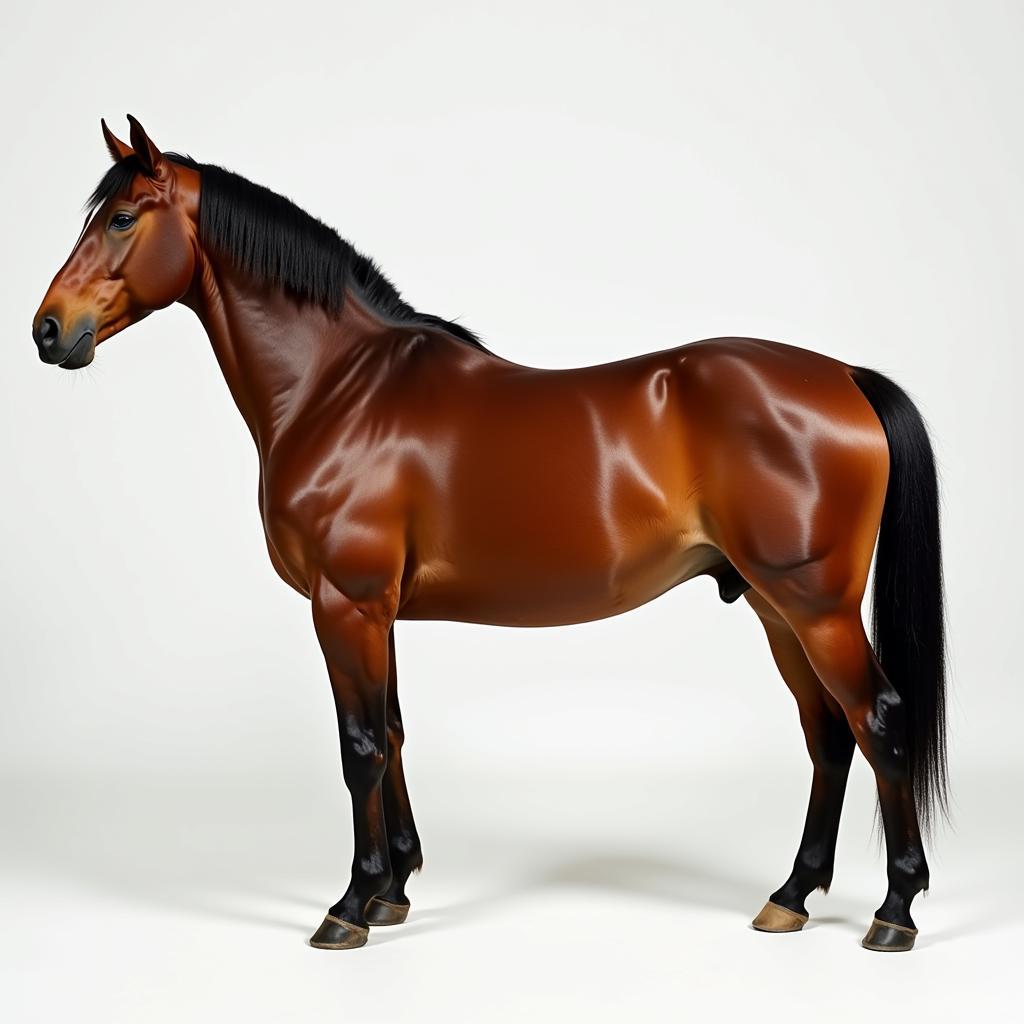Draft horse conformation plays a crucial role in their ability to perform work and their overall health and well-being. Understanding the ideal conformation for a draft horse is essential for both breeders and owners. This article will delve into the key aspects of draft horse conformation, focusing on the importance of proper structure and how it relates to breeding.
 Draft Horse Conformation: Side View
Draft Horse Conformation: Side View
The Importance of Conformation in Draft Horses
Conformation refers to the physical structure and arrangement of a horse’s body parts. For draft horses, correct conformation is vital for their ability to pull heavy loads efficiently and without injury. Poor conformation can lead to lameness, back problems, and reduced working life. Strong legs, a well-muscled back, and proper hoof structure are essential for supporting the weight and strain of heavy work. A balanced, well-proportioned physique allows for efficient movement and power transmission. Breeders carefully select breeding stock with excellent conformation to produce offspring with desirable traits, contributing to the overall improvement of the breed.
Key Elements of Draft Horse Conformation
Several key elements contribute to the ideal conformation of a draft horse. These include a strong, sloping shoulder, a short, strong back, a deep chest, well-muscled hindquarters, and strong, straight legs. The shoulder should be well-angled to allow for a long, free stride. The back should be short and strong to support the weight of the load being pulled. The chest should be deep and wide to provide ample room for the heart and lungs. Strong, well-muscled hindquarters provide the power needed for pulling. Finally, the legs should be straight, with strong joints and well-formed hooves.
Evaluating Leg Conformation
Evaluating leg conformation is particularly crucial. The legs should be straight when viewed from the front and back, with no significant deviations. The pasterns should be moderately sloped to absorb shock and allow for a smooth, comfortable gait. The hooves should be large and round, with a strong hoof wall. Proper leg conformation is crucial for preventing lameness and ensuring a long, productive working life.
The Role of Breeding in Maintaining Conformation
Careful breeding practices play a vital role in maintaining and improving draft horse conformation. Breeders select horses with desirable traits and breed them to produce offspring with improved conformation. This process involves careful evaluation of both the stallion and the mare, considering factors such as pedigree, performance records, and, most importantly, conformation. By selecting breeding stock with excellent conformation, breeders contribute to the overall health, longevity, and working ability of draft horses.
Common Conformation Faults in Draft Horses
While breeders strive for ideal conformation, certain faults can occur. These include upright pasterns, which can lead to increased concussion and lameness. A long, weak back can also be problematic, making the horse more susceptible to injury. Other common faults include sickle hocks, toeing in or out, and weak knees. Understanding these potential problems is essential for both breeders and owners, allowing for informed decisions regarding breeding and management.
Conclusion: Ensuring the Future of Draft Horses
Understanding and prioritizing Draft Horse Cock conformation is essential for maintaining the health, working ability, and longevity of these magnificent animals. By focusing on correct conformation through careful breeding and management practices, we can ensure the future of draft horses for generations to come. Remember, a well-conformed draft horse is not only more efficient and productive but also enjoys a healthier and more comfortable life.
FAQ:
- What is the ideal shoulder angle for a draft horse? A moderately sloping shoulder is preferred for a long, free stride.
- How can I assess the strength of a draft horse’s back? A short, well-muscled back is indicative of strength.
- What are the signs of poor leg conformation in a draft horse? Deviations from straightness, such as toeing in or out, and excessively sloped or upright pasterns.
- How does breeding impact draft horse conformation? Careful selection of breeding stock with desirable traits can significantly improve conformation in offspring.
- What are some common conformation faults that can lead to lameness? Upright pasterns, sickle hocks, and weak knees can predispose a horse to lameness.
- Why is hoof care important for draft horses? Large, strong hooves are essential for supporting the horse’s weight and preventing lameness.
- How can I learn more about draft horse conformation? Consult with experienced breeders, veterinarians, and equine professionals.
For further assistance, please contact us at Phone: 0772127271, Email: justushorses@gmail.com or visit our address: QGM2+WX2, Vị Trung, Vị Thuỷ, Hậu Giang, Việt Nam. We have a 24/7 customer service team.